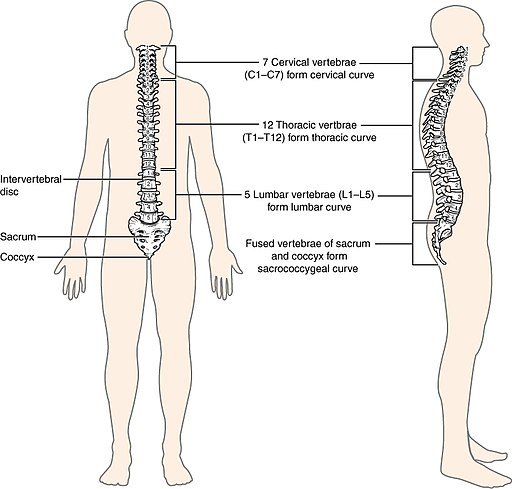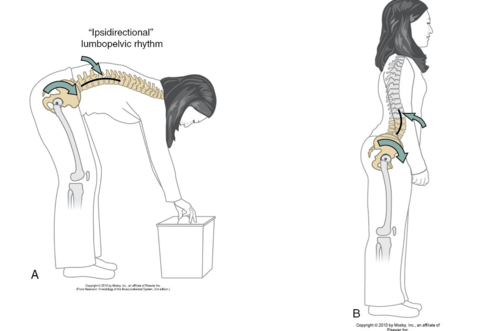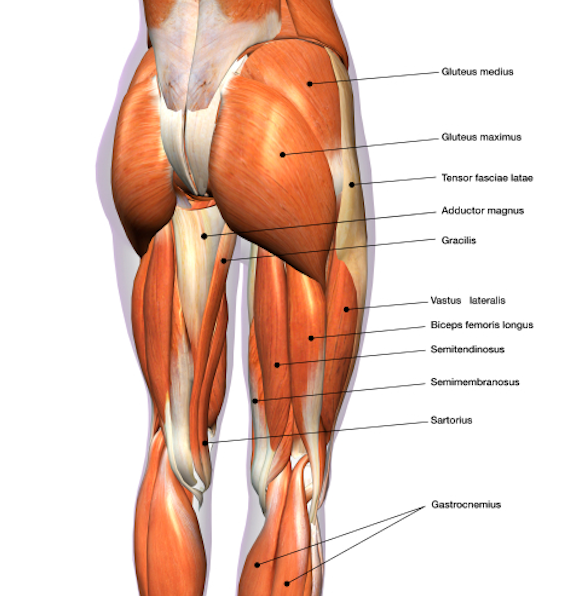The human body is a marvel of engineering, with various components working in perfect synchrony to perform daily functions. At the heart of this is the lumbopelvic rhythm, an intricate dance between the lumbar spine and the pelvis. Understanding this rhythm is key to appreciating how our bodies function and move.
The role of muscle groups, the significance of maintaining a healthy lumbopelvic rhythm relationship.
The Erector Spinae are three muscle groups which play an important role in lumbopelvic rhythm. These muscle groups are the Iliocostalis Lumborum, Longissimus Thoracis, and Spinalis Thoracis.
These muscles originate from the sacrum and extend vertically on either side of the spine.
During forward bending and anterior pelvic tilt, these muscles lengthen, providing stability and maintaining posture. These muscles contract when returning to an upright position. This tilts the pelvis posteriorly and reduces the load on the lumbar spine.
Similarly, the hamstring muscles and the gluteus maximus (hip extensor muscles) play a pivotal role in the mechanism of lumbopelvic rhythm. Muscles tense when they are under strain. This lengthening acts as a shock absorber and supports the body against gravity. This is especially noticeable during normal walking.
The lumbopelvic rhythm plays an important role in the body's mechanics. It helps maintain good posture and enables smooth, coordinated movements. It is essential for overall body functioning.
This rhythm disruption can cause discomfort and pain. It can even result in long-term spinal health issues.
Furthermore, a healthy lumbopelvic rhythm can contribute to injury prevention. Physical activities such as weight lifting require a well-coordinated lumbopelvic rhythm. This rhythm distributes the load efficiently, reducing the risk of lumbar spine injury.
In essence, the lumbopelvic rhythm serves as a cornerstone of spinal health and overall body mechanics. Recognizing any deviations from a healthy lumbopelvic rhythm can be the first step in preventing potential spinal issues.
Signs of a disrupted lumbopelvic
Disrupted lumbopelvic rhythm may include discomfort, pain, or stiffness in the lower back. It is advisable to seek professional help if you experience any of these symptoms. Physical therapists can provide targeted exercises and treatments to restore the balance and bring harmony back to your movements. Understanding and maintaining a healthy lumbopelvic rhythm is, therefore, crucial for our long-term wellbeing and optimal physical functioning.
The Erector Spinae is a collection of three muscle groups: the Iliocostalis Lumborum, Longissimus Thoracis, and Spinalis Thoracis. These groups have an instrumental role in the lumbopelvic rhythm.
These muscles originate from the sacrum and extend vertically on either side of the spine. During forward bending and anterior pelvic tilt, these muscles lengthen, providing stability and maintaining posture. When standing up, these muscles contract. This causes the pelvis to tilt backwards, which reduces the strain on the lower back.
Similarly, the hamstring muscles and the gluteus maximus (hip extensor muscles) play a pivotal role in the mechanism of lumbopelvic rhythm. Muscles tension causes them to lengthen under strain. This serves as a shock absorber and supports the body against gravity, especially during walking.
A healthy lumbopelvic rhythm is important for body mechanics. It helps keep good posture and allows for easy, coordinated movements. This rhythm disruption can cause discomfort and pain. It can also lead to long-term spinal health issues.
Furthermore, a healthy lumbopelvic rhythm can contribute to injury prevention. Physical activities such as weight lifting require coordination between the lumbar and pelvic regions. This rhythm helps to distribute the load evenly, thus reducing the risk of injury to the lumbar spine.
In essence, the lumbopelvic rhythm serves as a cornerstone of spinal health and overall body mechanics. Recognizing any deviations from a healthy lumbopelvic rhythm can be the first step in preventing potential spinal issues.
Signs of a disrupted lumbopelvic rhythm include discomfort, pain, and stiffness in the lower back. It is recommended to seek professional help if you are experiencing these symptoms. Physical therapists can provide targeted exercises and treatments to restore the balance and bring harmony back to your movements. Understanding and maintaining a healthy lumbopelvic rhythm is, therefore, crucial for our long-term wellbeing and optimal physical functioning.
The term "lumbo" relates to the lumbar spine, which comprises the lower five vertebrae, named L1 to L5. The vertebrae form the lower end of the spinal column. This column is a structural tower of 24 bones. It allows the body to have an upright posture.
The vertebral column has five regions: the cervical spine, thoracic spine, lumbar spine, sacrum, and coccyx. Each of these regions has a specific function and helps the body move.
The lumbar spine allows for different movements in multiple directions. These include flexion and extension (movement back and forth), side bending (side-to-side movement), and rotation (twisting). Notably, the position of the lumbar spine is closely tied to the posture of the sacrum and pelvis. Thus, any alteration in pelvic posture invariably affects the positioning of the lumbar spine and sacrum.
Three primary muscle groups participate in spinal motion: extensor muscles, flexor muscles, and oblique muscles. Extensor muscles, located in the spine's rear, help maintain an erect posture and assist with object lifting. Conversely, flexor muscles, found in the spine's front, facilitate forward bending, lifting, and arching. Lastly, oblique muscles, positioned at the sides of the spine, assist with spinal rotation and posture maintenance.
what is lumbopelvic rhythm?
This term describes the synchronized movement between the lumbar spine and the pelvis during forward and backward motions. Coordination involves flexion and extension movements along the sagittal plane. This plane bisects the body into right and left halves.
Forward bending, or trunk flexion, involves hip flexion and anterior pelvic tilt. The erector spinae, a group of muscles, lengthens to maintain posture.
These muscles include the Iliocostalis Lumborum, Longissimus Thoracis, and Spinalis Thoracis. These muscles, originating from the sacrum, run vertically on either side of the spine. The pelvis tilts posteriorly when returning to an upright position. The erector spinae contract, taking the pressure off the lumbar spine.
Key to this mechanism are the hip extensor muscles, including the hamstring muscles and the gluteus maximus. Tension in these muscles causes them to lengthen under strain. This is known as eccentric activation. It helps counteract gravity and absorb shock during activities like walking.
The lumbopelvic rhythm plays a pivotal role in maintaining a healthy posture of the pelvis and the lumbar spine. Disruption of this rhythm can lead to postural distortions in the lumbar spine and beyond, causing discomfort and pain.
What if this rhythm falls out of sync? and the role of at home Physical Therapy
Lumbopelvic rhythm dysfunction can cause several problems and different types of pain. The pelvis tilts anteriorly, which increases pressure on the facet joints. A posterior tilt causes the lumbar spine to flex forward, leading to increased pressure on the vertebral discs.
There are many causes of lumbopelvic dysfunction. Issues affecting the lumbopelvic area include: - Muscle weakness or tightness - Malalignment - Ligament damage - Hypermobility or hypomobility - Unnecessary stress or strain on the joints. This can cause pain or muscle spasms.
Low back pain or stiffness can be a telltale sign of disrupted lumbopelvic rhythm. However, hope is not lost. Physical therapists can assist in restoring this rhythm by enhancing body awareness, promoting neuromuscular re-education, and instilling healthier movement patterns. Through these methods, it's possible to regain control and harmony in your lumbopelvic rhythm, and hence, enhance your quality of life.
The lumbopelvic rhythm is much more than mechanical coordination. It is a testament to the complexity and harmony of the human body. Disruptions can be uncomfortable and painful. However, by understanding the rhythm and seeking assistance from a professional, it is possible to return to optimal functioning.
Conclusion
We have explored the concept of lumbopelvic rhythm. This includes its definition, the roles of lumbar spine mobility and pelvic tilt, and potential dysfunctions. It's clear that a well-coordinated lumbopelvic rhythm is integral to our daily activities and overall well-being. It's clear Lumbopelvic rhythm dysfunction can cause significant issues in your lower back.
But remember, if you're experiencing any discomfort or pain in your back or hip region, it could be a sign of lumbopelvic rhythm impairment or another related condition. Please don't ignore these signs.
At Be On The Move, We can improve your lumbopelvic rhythm by doing targeted exercises and making lifestyle modifications. This can enhance your mobility and reduce any discomfort or pain. Remember, your health and well-being are the top priority.
Feel free to reach out if you have any questions or concerns, or if you would like to schedule a consultation. At Be On The Move, our home health physical therapy practice in South Florida, we hold the understanding and treatment of lumbopelvic rhythm in high regard. Our seasoned team of professionals is proficient in diagnosing and addressing lumbopelvic rhythm disruptions. We recognize that each individual's body mechanics are unique, and we tailor our therapeutic approaches accordingly. By coming to your home, we provide a comfortable and convenient environment to help optimize your lumbopelvic rhythm. Through a variety of evidence-based interventions such as targeted exercises, neuromuscular re-education, and mobility training, we aim to restore the harmonious coordination between your lumbar spine and pelvis. Our ultimate goal is not only to alleviate discomfort and pain but also to equip you with the knowledge and strategies to maintain a healthy lumbopelvic rhythm, thereby enhancing your overall physical functioning and quality of life. At Be On The Move, we believe that understanding your body's unique rhythms is the key to unlocking a healthier, more active future.



See you soon,
Our experienced physical therapists in Boynton Beach, Boca Raton, Delray Beach, Lake Worth, and Wellington, Florida, are ready to support you through every step of your rehabilitation journey. Contact us today to schedule a personalized consultation and start your path to recovery.
See you soon,
//❤️ Trudy//
Disclaimer: The information provided in this blog post is for educational purposes only and is not intended as medical advice.
Every individual's situation is unique, and the content may not apply to your specific circumstances.
Always consult with your healthcare provider for personalized advice before starting any new exercise or treatment plan.
Be On The Move encourages all readers to maintain regular appointments with their doctors and to discuss any questions they may have about their conditions or any other health concerns.
What is Lumbopelvic Rhythm?
by Trudy Diraj on 2023-05-14
Experience top-quality in-home care
Book a Visit
Be On The Move
In-Home Physical Therapy
Be On The Move is the leading provider of in-home physical therapy in Florida. We proudly deliver exceptional care to hundreds of patients, helping them regain mobility and independence in the comfort of their own homes.

Trudy D
PT
Trudy D is a highly skilled physical therapist with extensive clinical experience in outpatient orthopedic and neurological disorders. Her comprehensive background underscores her deep clinical knowledge and commitment to exceptional patient care.

